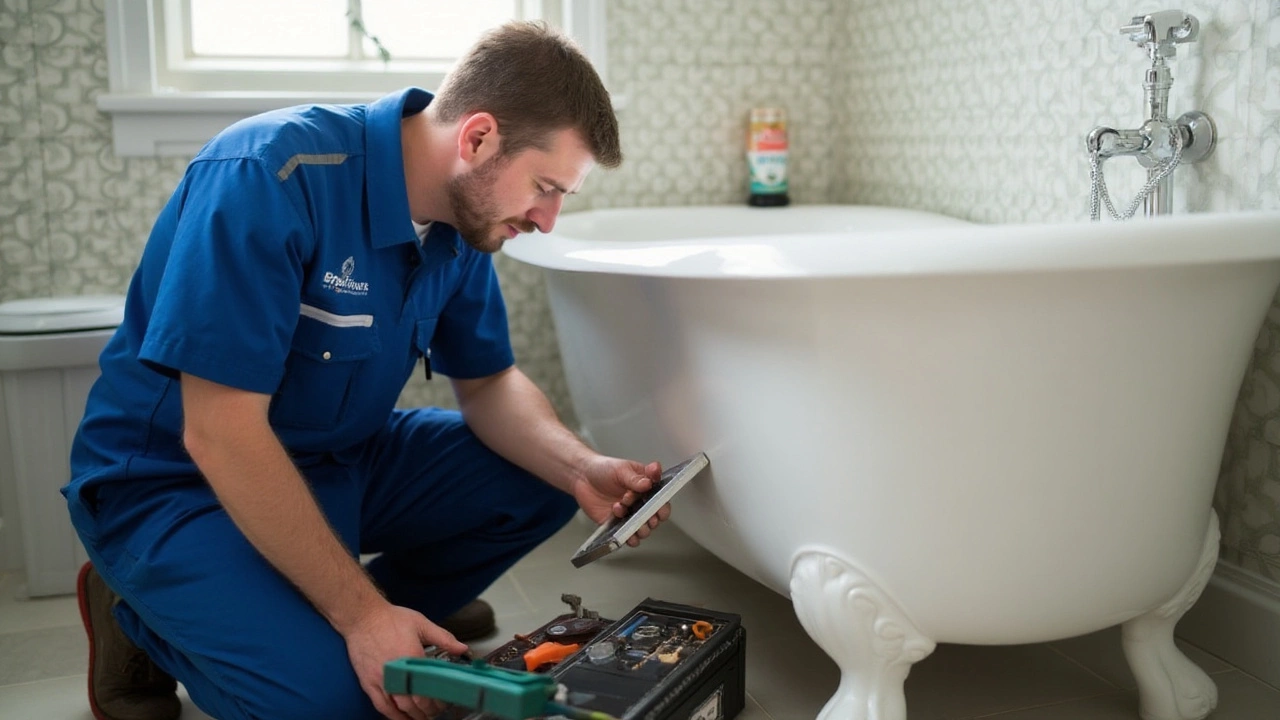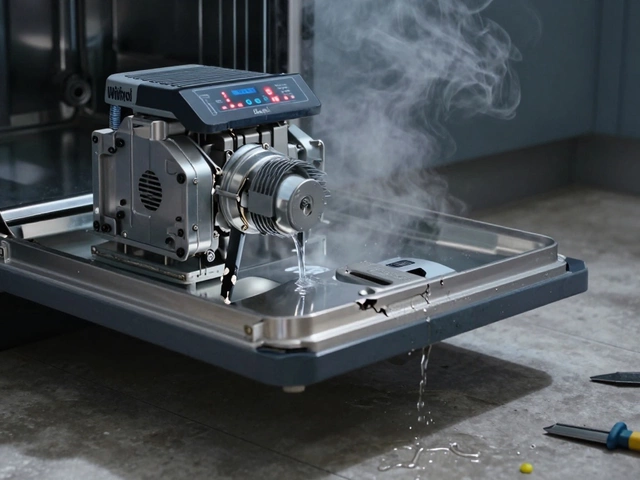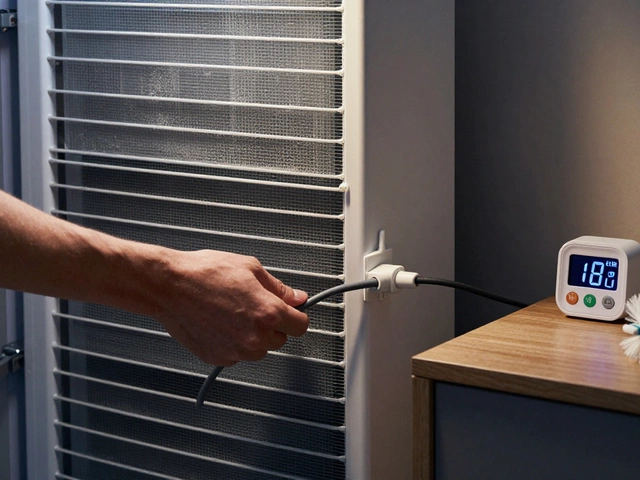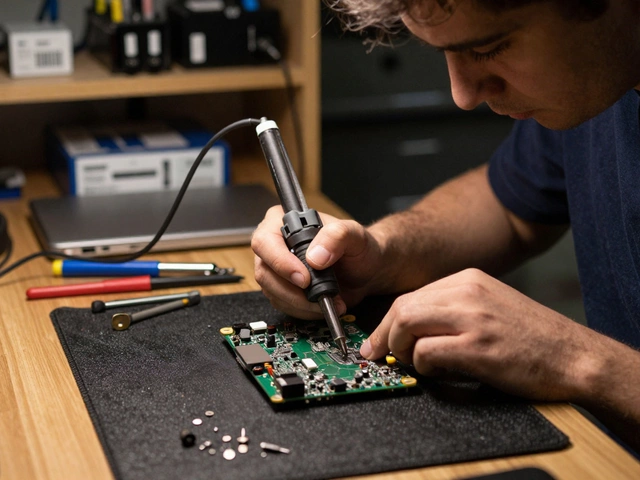Extractor fans are unsung heroes in our homes, tirelessly working to keep our air clean and fresh. Whether it’s in kitchens, bathrooms, or utility rooms, these devices quietly extract steam, odors, and airborne grease, preventing mold and maintaining indoor air quality. Yet, like any appliance, they can encounter problems that interrupt their function.
When your extractor fan starts acting up, knowing who to call becomes crucial. The nature of the problem might determine whether you can fix it yourself or need professional expertise. This involves understanding common issues, weighing the pros and cons of DIY repair, and recognizing when it’s time to ring up an expert.
In this article, we'll navigate the intricacies of extractor fan repairs, offering insights and practical advice to ensure your home’s air circulation system remains in top condition.
- Understanding Extractor Fan Problems
- DIY vs Professional Repair
- Selecting a Qualified Technician
- Cost Considerations
- Preventative Maintenance Tips
Understanding Extractor Fan Problems
Extractor fans play a vital role in keeping our living spaces fresh and odor-free. These mechanisms operate by drawing in stale air and expelling it outside, thus maintaining a healthier environment. However, over time, these extractor fan units can suffer wear and tear, leading to various malfunctions. Identifying the exact issue with an extractor fan can often be challenging, especially without a technical background. One common problem is a sudden decrease in suction power, which can stem from issues like blocked filters or ductwork obstructions. Buildups of grease and grime are often to blame, as they can seriously impede the fan’s ability to pull air effectively. Another frequent issue is strange noises emanating from the fan, which can range from humming to rattling or grinding. This might indicate loose parts, a worn ball bearing, or an unbalanced fan blade.
Other less common but equally frustrating problems include electrical issues, such as a completely unresponsive unit. Often, this is down to blown fuses, circuit breaker trips, or faulty wiring, especially in older models. Even the switch or control mechanism can fail, leaving users unable to operate the fan as needed. Inadequate ventilation can sometimes be traced back to improper installation, where the fan isn't correctly aligned with ductwork or positioned too far from exterior outlets. In some cases, the motor may have burned out due to overuse or overheating, which typically warrants a complete replacement. Awareness of these issues allows homeowners to assess whether they can tackle the problem themselves or if it's time to call in professional repair services.
Despite these technical hurdles, some solutions are straightforward and involve regular maintenance. Cleaning the fan and its components periodically can prevent buildup-related problems. For instance, filters need cleaning or replacing every few months, depending on usage, to ensure optimal airflow. In ducted systems, inspecting ducts for blockages or damage can also keep the system running smoothly. While on the topic, it’s worth noting: "Preemptive checks save more money than waiting for a complete shutdown," highlights industry expert John Rolfe in his HVAC maintenance column. These routine preventive measures might seem mundane but can significantly extend the lifespan of an extractor fan.
In some cases, pinpointing the problem might require a more methodical approach. There’s value in leveraging troubleshooting guides or community forums dedicated to ceiling fan maintenance. These resources can be treasure troves of insider tips and advice on tackling common fan issues. Additionally, such platforms often host discussions where one can ask questions and get insights from those who have faced similar challenges. In essence, understanding the intricate workings and potential pitfalls of your fan set-up lays the groundwork for either a successful DIY repair or a well-informed conversation with a technician.
DIY vs Professional Repair
Extractor fans, those silent movers of air that form an invisible line of defense against indoor air pollution, can seem quite daunting when they stop working. The decision to fix them yourself or bring in the professionals depends on several factors, including your confidence with tools, the complexity of the problem, and safety considerations. DIY repairs have proved effective for numerous household tasks, but there are times when a professional's touch is indispensable.
When the issue is simple, like a blown fuse or a blocked vent, a DIY approach may suffice. Checking the fuse box or clearing away obstructions from the vent can often breathe life back into a stalled fan. For those who enjoy hands-on tinkering, it might involve cleaning or replacing a clogged filter or tightening loose screws. These tasks are typically straightforward and can be tackled with minimal risk. However, it’s crucial to consider whether you're comfortable working on electrical appliances. Mishandling could lead to safety hazards such as electric shocks, making the choice of whether to DIY or hire a professional more pressing.
On the other hand, complex repairs involving electrical wiring or internal components usually call for the skill of a trained technician. Not only does this ensure the safety of the repair, but it also extends the lifespan of the fan by ensuring that all components are in harmony. Matthew Ford, a veteran HVAC technician, summarizes it well:
"While the urge to fix it fast is strong, knowing when to call a professional can prevent small issues from ballooning into expensive repairs."His words underscore the importance of recognizing one's limits.
Another consideration is the cost. On the surface, DIY solutions can appear more affordable, particularly when you're only dealing with minor parts or tools readily available at home. However, misjudging the problem can lead to larger costs down the line if professional intervention becomes necessary after a DIY misstep. Professional services typically include a thorough inspection, ensuring every possible fault is checked, plus, they often come with guarantees on labor and parts used.
In some cases, there may even be a need to weigh the costs of repair against the cost of purchasing a new fan altogether. If your fan is older or frequently requires repairs, replacing it could be a long-term saving. When making such decisions, online reviews and guides can be quite helpful, especially when they include ratings on efficiency and cost-effectiveness of brands.
Thus, troubleshooting and repair decisions involve a delicate balance of these factors. A good starting point is to assess the age and condition of your extractor fan, alongside understanding the basic problem at hand. There's a comfort in knowing you're not alone; whether you choose the DIY path or opt for professional repair, understanding what's involved is key to restoring your home's air quality seamlessly.

Selecting a Qualified Technician
Finding the right technician for your extractor fan repair can seem like an overwhelming task, but it's essential for ensuring that the job is done correctly and efficiently. A well-qualified technician not only restores your fan to good working order but also prolongs its life, ensuring the indoor air quality remains healthy. When choosing a technician, look for someone who specializes in ventilation systems as they often possess the specific expertise required for such repairs. This includes knowledge of both older models and the latest technology in exhaust systems. Ask potential candidates about their experience with kitchen exhaust systems and check whether they have handled similar issues like yours.
One significant factor to consider is certification. Technicians who have certifications from recognized bodies, such as the North American Technician Excellence (NATE) or HVAC Excellence, indicate a higher level of competency and commitment to their craft. These certifications require passing rigorous tests demonstrating proficiency and up-to-date knowledge, reassuring you of their capabilities. Always verify any qualification claims, as skilled labor scams can sometimes occur. Furthermore, verify that the technician is insured. In the event that something goes awry during the repair, this protection can save you from potential liabilities.
Another critical consideration is the cost, which should always be transparent. Before any work begins, request a detailed estimate outlining all potential charges, including labor and parts. This transparency is important to avoid unexpected fees. Be wary of technicians who provide quotes without inspecting the fan in person; this often leads to inaccurate estimates which might escalate costs significantly. Reviews and testimonials play an important role here too. Checking online reviews on platforms like Trustpilot or the Better Business Bureau (BBB) can provide insights into the reliability and reputation of a technician. References from friends or family who have had similar repairs can also be invaluable in making a trusted choice. In terms of obtaining competitive pricing, it’s beneficial to gather multiple estimates from different contractors.
"A good repair technician not only fixes the immediate problem but also offers maintenance tips for preventing future issues," advises John Stevens, a renowned home repair consultant.
Pay attention to the technician’s ability to communicate clearly about the problem and the solution. A skilled professional will not only handle the repair but will also educate you regarding proper maintenance, potentially saving you money down the line. Ensuring the technician is qualified, certified, and communicative helps build a transparent and reliable partnership, crucial for the longevity of your ceiling fan maintenance needs. The time you invest in finding the right technician can translate into decreased repair frequency and enhanced performance of your extraction systems over time.
Cost Considerations
Repairing an extractor fan comes with its own set of cost-related factors that homeowners need to juggle. The expenses can vary widely depending on several variables including the type, brand, and age of the fan, as well as the specific issue at hand. For instance, a broken switch or a simple wire disconnection might be easy on the wallet, while motor repairs or replacements can quickly run the tab higher. Understanding these nuances is crucial for making informed decisions about whether repair costs are justifiable compared to replacing the unit entirely.
Many homeowners might not realize that the geographic location also influences repair costs. In urban areas, labor costs tend to be higher due to the elevated cost of living. Conversely, rural areas might offer more affordable rates but could suffer from a lack of readily available skilled technicians. So, it’s wise to be aware of local market dynamics. Additionally, the time it takes to repair certain problems can push up costs. Technicians often charge by the hour, so a straightforward diagnosis typically results in a less painful bill.
Sometimes, you might find yourself contemplating a DIY approach to save money. However, this could backfire if the problem is misdiagnosed, potentially increasing the costs due to subsequent professional repairs to fix not only the original issue but any new ones caused by the attempted fix. A useful strategy is to initially address visible or simple problems, such as dirt accumulation on the fan blades or loose covers, before calling in the professionals for more complex issues.
A consideration often overlooked is the warranty. Some kitchen exhaust fans come with a warranty that could cover minor to major repairs. Checking the terms and conditions of any existing warranty before proceeding can save unexpected expenses. Consulting the warranty can also guide you to approved service providers, ensuring you don’t invalidate any agreements that could have otherwise saved you money.
"In many cases, understanding the underlying technology and the specific issue can result in more efficient and cost-effective solutions," says an expert from the Consumer Electronics Repair Association.Many people are surprised at how costs can balloon from minor issues when left unattended. Regular maintenance, as mundane as it may seem, often presents a significant cost-saving measure in the long run. Dusting and cleaning serve to extend the life of the fan, making it more efficient and less prone to costly repairs, thus minimizing the probability of sudden breakdowns.
If you are considering hiring a professional, it's beneficial to get quotes from multiple service providers. A reliable technician should provide clarity on what the costs cover, including parts, labor, and potential warranties on the work done. Additionally, inquiring about package deals that cover routine maintenance can be a smart move for comprehensive service at a discounted rate. Professional service can sometimes include insights into better usage practices that enhance the longevity of your fan, another layer in the cost consideration puzzle.

Preventative Maintenance Tips
Keeping your extractor fans in top shape doesn't necessarily require a major time commitment, but regular upkeep is crucial. By integrating a few simple maintenance routines, you can significantly enhance the lifespan and efficiency of your extractor fan. Dust and grease build-up are the arch-enemies of these devices, often leading to clogs that can strain the fan motor. To start, it's important to disconnect the fan from power before cleaning. Once that's out of the way, removing the cover lets you access the blades and inner mechanisms. A gentle wipe with a damp cloth should suffice for removing surface grime, while stubborn grease might need a solution of water and mild detergent.
This exercise should ideally happen every three months, or more frequently if your fan handles heavy loads, such as in busy kitchens. It’s not just about keeping the visible parts clean; the ducts and vents need attention too. These pathways are prone to gathering dust and debris, which can severely impact airflow. For some, reaching into these spaces involves a simple extension hose on a vacuum cleaner, while others might need professional duct cleaning services.
Consider regularly checking the fan’s wirings and connections as well. Over time, electrical parts can become loose or corroded, which might affect performance and increase the risk of fire hazards. If you're unsure about inspecting electrical components, calling in a professional is the safest route. Consistent lubrication of the fan's moving parts can also prevent wear and tear that might lead to costly repairs down the line.
Remember to not overlook filters, especially in kitchen exhaust systems. These components trap a significant amount of airborne grease and should be either cleaned or replaced as per the manufacturer’s guidelines. Some modern units come with indicator lights that suggest when a filter requires changes, but a general rule of thumb is every six to twelve months. An advantage of well-maintained filters is the improved efficiency of your fan, directly leading to energy savings and lower bills.
"Regular maintenance not only enhances the lifespan of your extractor fan but also ensures your home remains a healthy environment," says Dr. Emily Chen, an indoor air quality expert.
In addition, keeping an eye on any unusual noises can prevent small problems from becoming major headaches. Creaks, rattles, or grinding sounds could be signs of mechanical issues that might need professional attention. These noises could indicate anything from a loose screw to a failing motor. Addressing these as soon as they arise can save a significant amount of money and hassle in the long run. Monitoring fan speed can also be an indicator of potential trouble. If you notice your fan working harder without the desired results, it may be time for a deeper cleaning or repair.
Maintaining your extractor fan doesn't just make technical sense; it's a practice that contributes to a more sustainable home. By ensuring these fans remain unobstructed and efficient, you're also reducing their energy consumption, which is kinder to both the planet and your wallet. Ultimately, a few proactive steps are all it takes to keep these vital appliances running smoothly, ensuring your home remains a fresh, odor-free sanctuary.





